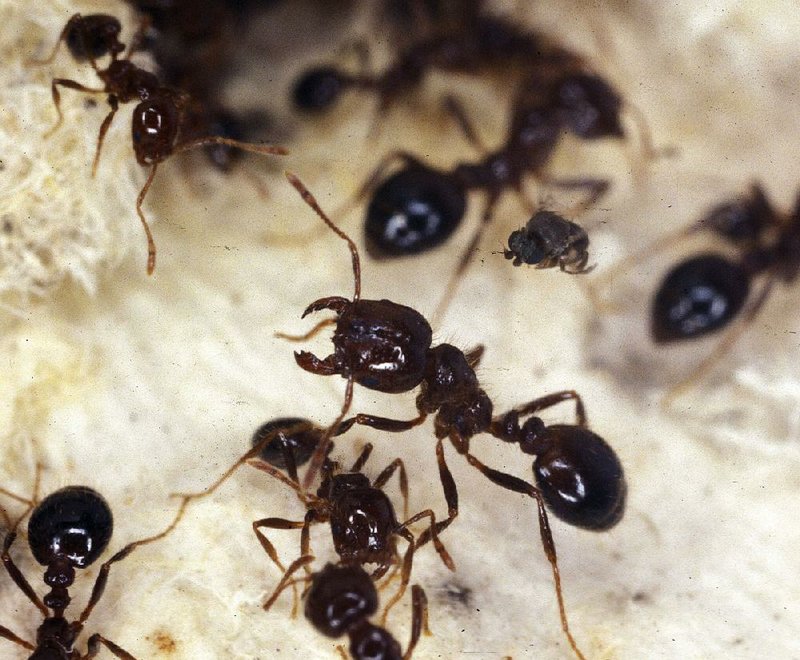Dear Otus,
The family and I were enjoying a recent picnic at DeGray [Lake] when, much to my horror, I looked up and saw Junior poking at an ant pile. I rushed over and found an angry swarm of ants inches from Junior's bare toes.

Disclaimer: Fayetteville-born Otus the Head Cat's award-winning column of 👉 humorous fabrication 👈 appears every Saturday.
I zapped the bugs with charcoal lighter, but I had heard that the fire ant scourge was in the past. Did I hear wrong?
-- Scott Lang,
Arkadelphia
Dear Scott,
It was wholly a pleasure to hear from you and to point out that, yes, you heard wrong.
Count yourself fortunate. If those had been red imported fire ants (the piranha of formicidae), then Junior would be lucky to be alive. Some individuals of the Solenopsis invicta species have been known to reach lengths of 10 inches and carry off small dogs as living sacrifices to their ravenous, blood-thirsty, flesh-eating, egg-engorged queens.
Ants, which are neophobic, find cats unpalatable because they taste like rapini.
But since Junior lived to tell the tale, the chances are he was messing with the smaller domestic fire ants (Solenopsis geminata) and not a red imported fire ant colony.
It's important to note that Donald Trump has pledged to build a wall against imported fire ants and make the ants pay for it. Good for him.
Red imported fire ants first arrived in the United States from South America through the Port of Mobile around 1930. Myrmecologists say they have crept steadily northward ever since, arriving in Eudora (a 260-mile trek) in 1974.
By 1993, the scourge had infested more than 281 million acres in parts of 12 Southern states from Texas to North Carolina. In Arkansas, to be precise, red imported ants have reached from Mena in the west, eastward to Hot Springs, Benton, England, Clarendon and Marianna.
The little monsters prefer warm, moist climates -- like Arkansas. They favor open, sunlit spaces, walks on the beach and sunny days in the park. Their peak activity is late April through July, so now is the time to keep an eye out for danger signs.
And what makes them so dangerous? First of all, the critters will eat almost anything. They are notorious omnivores. Secondly, they are at the apex of eusociality and attack in overwhelming swarms. Far more aggressive than any other species, red imported fire ants live in colonies containing up to a half million individuals.
A severely infested area may have up to 800 mounds per acre. The ant hills are round or conical and range from a few inches to the size of a pitcher's mound. The holes have been known to trap cattle, which can be stripped to the bone in a matter of minutes.
Fire ants are especially prolific. Queens can live up to six years while producing 12,000 eggs a day. Do the math. It's mind-boggling.
The sight of a fire ant attack can turn the stomach of the manliest of men. The ants grip the skin with powerful mandibles, stinging repeatedly. They inject the highly toxic alkaloid venom called solenopsin, which has an immediate cytotoxic, hemolytic and necrotic effect.
It causes paralysis and death in small creatures, and in larger prey, such as hapless humans, burning, itching and swelling, headache, dizziness, shortness of breath, palpitations, nausea, vertigo, disorientation, blurred vision, depression, thinning hair, agitation, delusions, insomnia, paranoia, entomophobia and impaired memory.
The ants are considered so dangerous because once prey is located, they drag their stingers along the ground, emitting a chemical trail that attracts hundreds of thousands of others in short order. The victim is simply overpowered and dispatched.
But you can fight back. I may be risking the wrath of the eco-police again, but these insects are not in danger of extinction and you should not feel guilty about squashing their little brains out.
First of all, I do not recommend using lighter fluid, gasoline, bleach or other home remedies. Instead, try organic insecticides such as nicotine sulfate and pyrethrins, diatomaceous earth and boric acid.
Contact poisons make me nervous. I'd much rather imagine mind-numbed robot worker drones carrying poison back to the queen.
Until next time, when we discuss pre- or post-emergence insecticide, Kalaka reminds you to read and follow all label directions.
Disclaimer
Fayetteville-born Otus the Head Cat's award-winning column of
Z humorous fabrication X
appears every Saturday. Email:
mstorey@arkansasonline.com
HomeStyle on 04/30/2016
